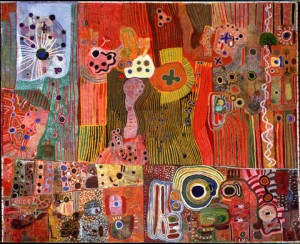The recent death of mathematician Jim Wiegold (1934-2009), whom I once knew, has led me to ponder the nature of intellectual influence. Written matter – initially, hand-copied books, then printed books, and now the Web – has been the main conduit of influence. For those of us with a formal education, lectures and tutorials are another means of influence, more direct than written materials. Yet despite these broadcast methods, we still seek out individual contact with others. Speaking for myself, it is almost never the knowledge or facts of others, per se, that I have sought or seek in making personal contact, but rather their various different ways of looking at the world. In mathematical terminology, the ideas that have influenced me have not been the solutions that certain people have for particular problems, but rather the methods and perspectives they use for approaching and tackling problems, even when these methods are not always successful.
To express my gratitude, I thought I would list some of the people whose ideas have influenced me, either directly through their lectures, or indirectly through their books and other writings. In the second category, I have not included those whose ideas have come to me mediated through the books or lectures of others, which therefore excludes many mathematicians whose work has influenced me (in particular: Newton, Leibniz, Cauchy, Weierstrauss, Cantor, Frege, Poincare, Pieri, Hilbert, Lebesque, Kolmogorov, and Godel). I have also not included the many writers of poetry, fiction, history and biography whose work has had great impact on me. These two categories also exclude people whose intellectual influence has been manifest in non-verbal forms, such as through visual arts or music, or via working together, since those categories need posts of their own.
Teachers & lecturers I have had who have influenced my thinking include: Leo Birsen (1902-1992), Sr. Claver Butler RSM (ca. 1930-2009), Burgess Cameron (1922-2020), Sr. Clare Castle RSM (ca. 1920- ca. 2000), John Coates (1945-2022), Dot Crowe, James Cutt, Bro. Clive Davis FMS, Tom Donaldson (1945-2006), Gary Dunbier, Sol Encel (1925-2010), Felix Fabryczny de Leiris, Claudio Forcada, Richard Gill (1941-2018), Myrtle Hanley (1909-1984), Sr. Jennifer Hartley RSM, Chip Heathcote (1931-2016), Hope Hewitt (1915-2011), Alec Hope (1907-2000), John Hutchinson, Marg Keetles, Joe Lynch, Robert Marks, John McBurney (1932-1998), David Midgley, Lindsay Morley, Leopoldo Mugnai, Terry O’Neill, Jim Penberthy* (1917-1999), Malcolm Rennie (1940-1980), John Roberts, Gisela Soares, Brian Stacey (1946-1996), James Taylor, Frank Torpie (1934-1989), Neil Trudinger, David Urquhart-Jones, Frederick Wedd (1890-1972), Gary Whale (1943-2019), Ted Wheelwright (1921-2007), John Woods and Alkiviadis Zalavras.
People whose writings have influenced my thinking include: John Baez, Ole Barndorff-Nielsen (1935-2022), Charlotte Joko Beck (1917-2011), Johan van Bentham, Mark Evan Bonds, John Cage (1912-1992), Albert Camus (1913-1960), Nikolai Chentsov (1930-1992), John Miller Chernoff, Stewart Copeland, Sam Eilenberg (1913-1998), Paul Feyerabend (1924-1994), George Fowler (1929-2000), Kyle Gann, Alfred Gell (1945-1997), Herb Gintis, Jurgen Habermas, Charles Hamblin (1922-1985), Vaclav Havel (1936-2011), Lafcadio Hearn (1850-1904), Jaakko Hintikka (1929-2015), Eric von Hippel, Wilfrid Hodges, Christmas Humphreys (1901-1983), Jon Kabat-Zinn, Herman Kahn (1922-1983), John Maynard Keynes (1883-1946), Andrey Kolmogorov (1903-1987), Paul Krugman, Imre Lakatos (1922-1974), Trevor Leggett (1914-2000), George Leonard (1923-2010), Brad de Long, Donald MacKenzie, Saunders Mac Lane (1909-2005), Karl Marx (1818-1883), Grant McCracken, Henry Mintzberg, Philip Mirowski, Michel de Montaigne (1533-1592), Michael Porter, Charles Reich (1928-2019), Jean-Francois Revel (1924-2006), Daniel Rose, Bertrand Russell (1872-1970), Pierre Ryckmans (aka Simon Leys) (1935-2014), Oliver Sacks (1933-2015), Gunther Schuller (1925-2015), George Shackle (1903-1992), Cosma Shalizi, Rupert Sheldrake, Raymond Smullyan (1919-2017), Rory Stewart, Anne Sweeney (d. 2007), Nassim Taleb, Henry David Thoreau (1817-1862), Stephen Toulmin (1922-2009), Scott Turner, Roy Weintraub, Geoffrey Vickers VC (1894-1982), and Richard Wilson.
FOOTNOTES:
* Which makes me a grand-pupil of Nadia Boulanger (1887-1979).
** Of course, this being the World-Wide-Web, I need to explicitly say that nothing in what I have written here should be taken to mean that I agree with anything in particular which any of the people mentioned here have said or written.
A more complete list of teachers is here.
